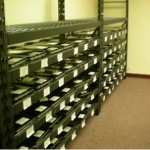Summertime Work at Summit Builds a New Blended Learning Environment
By Guest Blogger Bryant Wong, Director of Technology, Summit Public Schools
This year, Summit will be introducing a new blended learning environment for students, with each student having their own laptop, wider internet access around campus, and a more technologically focused classroom. This would return teacher-student interaction to a smaller, more personalized format, which fits perfectly with Summit’s goals of providing a strong and supportive learning environment where students have access to the assets they need, not limited by the technology around them. Our goal this summer for Rainier and Tahoma was to construct a reliable technological backbone and classroom environments with sturdy infrastructure to support students effectively. Both campuses will be expanding into two different on-site areas that have never been touched before. These sites began in not the most lavish conditions, with holes in the floor, missing parts of ceiling, and outdated wiring and Ethernet capabilities – a veritable jungle of aging walls and hanging cables. After taking a hold of the situation, it was clear that a lot of work was ahead of us. Thankfully, with help from ACE, we were much better prepared to tackle the hectic summer.
The introduction of two-hundred new students and the concept of a blended learning environment made it clear that new infrastructure would be necessary. In order to accommodate these changes, two-hundred and fifty laptops and thirteen access points were purchased for the school. Each laptop would be imaged with specific restrictions in mind and joined to the school’s domain. With these new additions, the entire student population will have access to the software they need with full internet coverage across campus. By assigning each student their own laptop, we hope to stress the importance of responsibility and give no student an excuse not to meet and exceed expectations.
As mentioned before, each computer needed to have a uniform image (a snapshot of the operating system that can be applied to multiple computers), so cloning each laptop with that image was essential. In order to tackle the cloning issue as quickly and cheaply as possible, we delved into the world of open-source software and used Clonezilla. However, there were some issues – laptops would occasionally not be able to connect to the Clonezilla server and would fail in the middle of installation, while also sending the computers into infinite boot loops. These issues would be resolved through experimentation and looking over the Clonezilla documentation. In only three weeks of hard work, we were able to clone almost every laptop and join them to Summit’s domain. Since cloning was typically a hands-off affair, we were able to use our free time to tackle other tasks such as putting up access points, checking projectors, managing networks, and more.
To make things simple and orderly, each laptop had to be named according to a specific naming convention and added to the schools’ domain. By using existing servers, an active directory was developed to maintain a joinable domain, and each laptop was manually assigned a specific name and joined to the student domain. We ran into some problems along the way, with some laptops refusing to join the domain, requiring us to pay personal attention to the laptop in order to resolve its issues. This experience, however, helped us deal with real-world troubleshooting and taught us a great deal about dealing with unexpected problems as they arose. Our finished product was a stable and reliable network, supporting multiple computers that could be logged into by any student across the campus.

Laptop "Lockers" -- each laptop has a rack slot so students don't have to lug them in their backpacks
With so many new laptops, we needed new places to put them – after all, it would not be very efficient to have laptops scattered around campus. Therefore, we decided to build industrial racks to house the laptops in the classrooms. Each laptop was designated a certain spot on the rack that corresponded with a particular student and school. This allowed for students to have a clear place to put their laptops, without having to lug the additional weight around in their backpacks. The addition of the racks would also help prevent students from losing or misplacing their laptops, since they would ideally be putting their laptops back in their assigned spaces. However, powering the racks proved to be a challenge since the campus was not designed to support eighty to one hundred laptops for every classroom. This problem was dealt with by installing a power conduit in each of the classrooms housing the laptops.
Due to allowing so many new students having their own laptops and internet, the firewall needed updating. We are all familiar with the seductive siren call of the internet, the lure of spending time on Facebook, Youtube or Tumblr. In order to prevent the students from accessing these sites, we obtained a firewall to block these sites, other inappropriate content, and unnecessary network usage. We spent some time trawling through the internet, blocking sites as we went, and placing calls to the firewall tech support whenever problems arose. We knew that without a good firewall, the network and students are at risk. A great amount of time and money was spent to ensure the firewall was secure.
After one summer’s worth of work, much has been accomplished; the campus was practically reborn. Students can immerse themselves in a blended environment with the introduction of personal laptops. Through teamwork and a great deal of effort, Summit created a positive and secure learning environment that blends education and technology seamlessly.
